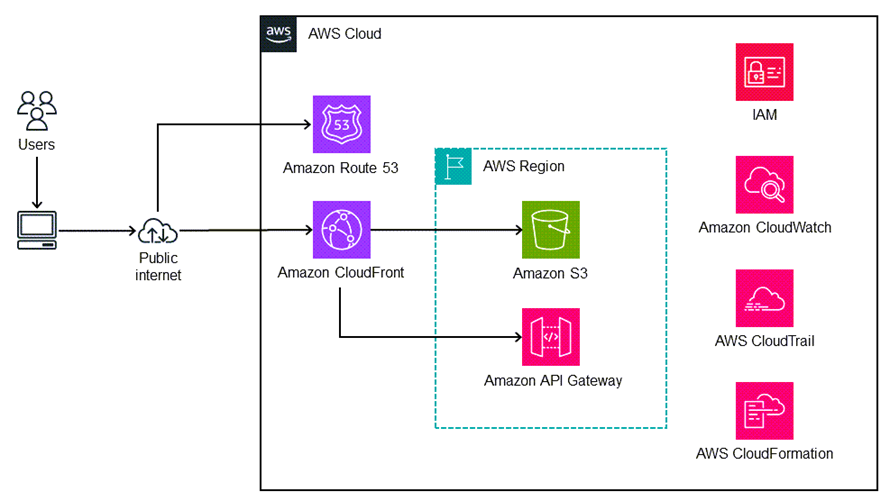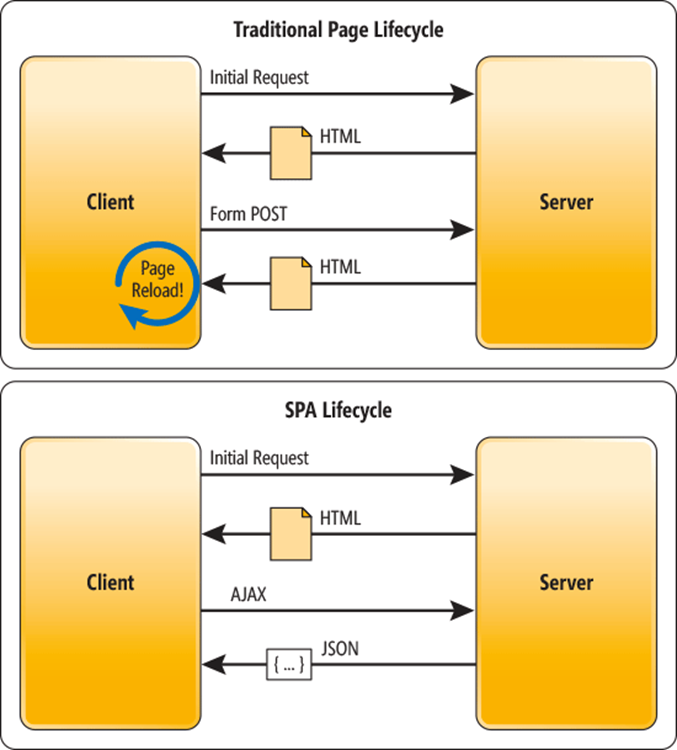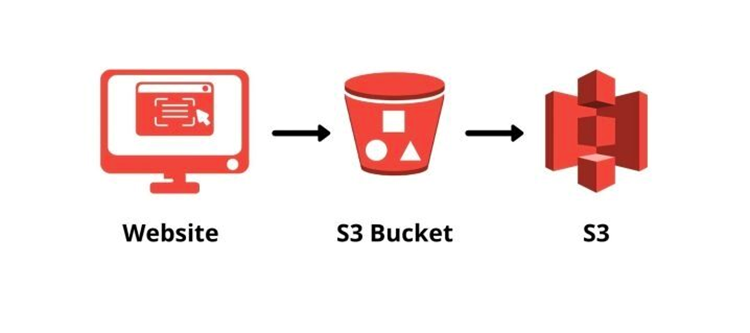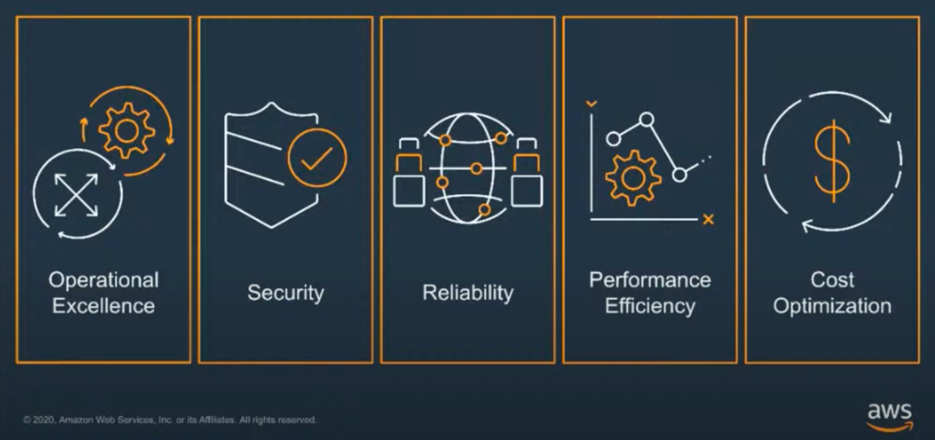Single-page applications dynamically update content without a full page reload, providing seamless user experiences. Amazon Simple Storage Service (S3) supports hosting Single-Page Applications (SPAs) due to its static website hosting capabilities.
To store an SPA, users must first enable static web hosting for a designated bucket, adding the permissions for public access. Then, the SPA files, including HTML, JavaScript, CSS, and other needed files, can be uploaded to the bucket. With the correct setup, Amazon S3 can host SPAs, providing scalable, cost-effective, and reliable hosting solutions.

What is a Single-Page Application (SPA)?
The term Single-Page Application (SPA) was first used in 2002. It is a web application that functions within a single HTML page and dynamically updates its content without requiring full page reloads during user interactions. This approach allows for a more fluid and responsive user experience.
The most popular examples of SPA are the most used applications—Netflix, Facebook, and Gmail. Companies use SPAs developed on frameworks like React and Angular to build scalable experiences.
- Netflix: The prevalent entertainment streaming service employs the React framework to allow users to seamlessly access their TV box sets and movies without going through much lag.
- Facebook: The news feed on Facebook is one instance of a single-page web app. Precise chunks of content are loaded on the page when you scroll through the past videos or click on various buttons. You do not have to leave the page to endure the experience.
- Gmail: As you click on messages in your inbox, the browser remains on the same web page.

What is Amazon S3?
Amazon Simple Storage Service (S3) was launched on March 14, 2006, as a fully managed cloud-based object storage service of Amazon Web Services (AWS). It enables users to store, retrieve, and manage large amounts of data with high durability, availability, and security. S3 is highly scalable and cost-effective, making it suitable for multiple use cases, including data storage, backup, content distribution, and big data analytics. Apart from data storage functionality, the AWS S3 bucket provides a remarkable feature of static website hosting over it.
Most websites are becoming static, meaning they run zero server-side code and consist of only HTML, CSS, and JavaScript. With no server-side code to run, there is no reason to host them on a traditional server. Using the static website hosting feature on an S3 bucket, we host static websites for one to two dollars a month and scale to handle millions of users.

Benefits of Using SPAs with Amazon S3

Scalability
Scalability in Single Page Applications (SPAs) with Amazon S3 primarily revolves around efficiently handling user traffic, managing resources, and ensuring high availability. Amazon S3 is mainly designed for storing and retrieving data and can be used in SPAs to serve static assets, such as HTML, CSS, JavaScript, images, and other media files.
Some ways that scalability is applied to SPAS are:
- Content Delivery via Amazon CloudFront: Use Amazon CloudFront as a Content Delivery Network (CDN) to distribute the SPA's static assets (HTML, CSS, JavaScript) to edge locations worldwide. This would help improve load times for users by serving content from a location closer to them, enhancing the application's scalability.
- Multi-Region Replication: If the SPA has a global user base, consider replicating the SPA assets across multiple Amazon S3 buckets in different AWS regions. This provides low-latency access to users in different regions and enhances availability by mitigating regional outages.
- Horizontal Scaling for APIs: If the SPA interacts with APIs, design the APIs to scale horizontally. As demand increases, you can add more instances of your API service to handle the load, ensuring responsiveness and availability.
- S3 Object Versioning: Enable S3 object versioning to maintain a version history of your SPA assets. This provides the ability to roll back to previous versions in case of errors or issues, ensuring a more scalable and reliable deployment process.
- Continuous Deployment and Automation: Set up automated deployment pipelines using AWS CodePipeline and AWS CodeDeploy. This streamlines the process of deploying updates to your SPA, making it easier to scale by reducing manual intervention and potential errors.
Combining these practices allows you to create a highly scalable architecture for hosting SPA in Amazon S3 while ensuring optimal performance and user experience.
Cost-Effectiveness
Amazon S3 is a highly scalable and cost-effective storage service provided by Amazon Web Services (AWS) that allows you to store and retrieve large amounts of data. Amazon S3 follows a pay-as-you-go pricing model, where you pay only for the storage you use and the data transfer out of the service. This means you don't have to invest in expensive infrastructure upfront and only pay for the resources consumed, making it cost-effective for SPAs that may have varying traffic and storage needs.
Here are a few examples of how using Amazon S3 for hosting SPAs can be cost-effective:
- Low Storage and Data Transfer Costs: Amazon S3 provides affordable storage and data transfer pricing. Since SPAs consist mainly of static files (HTML, JavaScript, CSS, images, etc.), the storage requirements are relatively low. Additionally, data transfer costs are reasonable, especially for lower levels of traffic.
- Pay-as-You-Go Pricing: Amazon S3 follows a pay-as-you-go pricing model, which means you only pay for the storage and bandwidth you use.
- No Server Management Costs: Traditional web hosting often involves server management and maintenance costs. With Amazon S3, you eliminate these costs because S3 is a fully managed service. You don't need to worry about server updates, security patches, or scaling issues.
- Serverless Architecture: Using Amazon S3 to host SPAs aligns with a serverless architecture, where you only pay for the resources you use. This eliminates the need for provisioning and maintaining servers, which can lead to significant cost savings.
- Reduced Infrastructure Complexity: By hosting your SPA on Amazon S3, you reduce the complexity of your infrastructure. This can lead to cost savings in terms of infrastructure management, monitoring, and troubleshooting.
While Amazon S3 is cost-effective for hosting SPAs, keep in mind that the specific cost savings will depend on the size of your application, its traffic, and your usage patterns. Monitoring your usage through the AWS Management Console and setting up cost alerts can help you manage and optimize your costs effectively.
Security
Securing SPAs that use Amazon S3 for hosting is essential to protect your application and its data from unauthorized access and potential security threats. SPA security is a critical aspect of web development, handles sensitive user data, and relies heavily on client-side code execution. Failing to implement proper security measures can lead to vulnerabilities such as Cross-Site Scripting (XSS), Cross-Site Request Forgery (CSRF), and data breaches. Adopting robust security practices is essential to safeguard user data, ensure data integrity, and maintain user trust.
Leveraging Amazon S3 for hosting SPAs offers several benefits that contribute to enhanced security:
- Access Control and Permissions with AWS Identity and Access Management (IAM) roles and policies.
- Data Encryption (SSL/TLS).
- Content Delivery integrating Amazon CloudFront and AWS's content delivery network (CDN).
- Versioning and Rollback.
- Logging and Monitoring through Amazon CloudWatch.
Remember that security is a multi-layered approach, and these practices should be combined and customized based on your specific security needs and compliance requirements.
Reliability
Reliability in the context of an SPA using Amazon S3 refers to the ability of the application to work consistently and without downtime. Amazon S3 is commonly used for storing and serving static assets like images, videos, and web pages, which makes it an ideal choice for hosting SPAs.
Here are a few examples:
- Versioned Bucket: Create a versioned S3 bucket to host your SPA. This ensures that every change you make to your SPA's files is saved as a new version. In case of accidental deletions or modifications, previous versions can be easily restored.
- Data Lifecycle Policies: Implement data lifecycle policies to automatically transition older versions of files to less expensive storage classes or even delete them after a certain period. This helps optimize costs while maintaining necessary data.
- Cross-Origin Resource Sharing (CORS): Configure CORS settings to define which domains are allowed to access your SPA's resources. This helps prevent unauthorized access and ensures proper security.
- Monitoring and Alerts: Set up CloudWatch alarms to monitor your S3 bucket's metrics, such as object counts, storage usage, and request rates. This allows you to proactively identify and address issues.
- Automated Testing and Deployment: Implement continuous integration and continuous deployment (CI/CD) pipelines to automate the testing and deployment of your SPA. This reduces the chance of introducing errors during manual deployments.
Hosting an SPA on Amazon S3 provides a reliable foundation and application-level practices such as proper coding, error handling, and security measures, all of which are crucial for ensuring overall reliability.
Conclusion
In conclusion, Single-Page Applications have emerged as a transformative approach to web development, offering enhanced user experiences and efficient resource utilization. Amazon S3, a robust and scalable cloud storage service, plays a significant role in hosting SPAs, enabling seamless deployment and content delivery.
SPAs excel at delivering dynamic content and interactivity by minimizing page reloads, resulting in faster load times and smoother interactions. Amazon S3's low-latency distribution and content caching capabilities amplify these benefits, ensuring a responsive user interface regardless of geographic location.
Furthermore, the cost-effectiveness and scalability of Amazon S3 make it an attractive choice for hosting SPAs. Its pay-as-you-go model and ability to handle sudden traffic spikes align well with the variable usage patterns often seen in SPAs.
In a digital landscape driven by user-centric experiences, the combination of Single-Page Applications and Amazon S3 opens doors to crafting dynamic, responsive, and scalable web applications that cater to modern expectations and demands.
Acknowledgment
This piece was written by Ivan Castorena at Encora.
About Encora
Fast-growing tech companies partner with Encora to outsource product development and drive growth. Contact us to learn more about our software engineering capabilities.
References
Host a static website - FAQs. (s. f.). https://aws.amazon.com/getting-started/hands-on/host-static-website/faq/
Cloud Object Storage – Amazon S3 (s. f.). https://aws.amazon.com/s3/
Hosting a static website using Amazon S3 - Amazon Simple Storage Service. (s. f.). https://docs.aws.amazon.com/AmazonS3/latest/userguide/WebsiteHosting.html
What is Amazon S3? - Amazon Simple Storage Service. (s. f.). https://docs.aws.amazon.com/AmazonS3/latest/dev/Welcome.html
Low-Latency Content Delivery Network (CDN) - Amazon CloudFront. (s. f.). https://aws.amazon.com/cloudfront/
Application and Infrastructure monitoring – Amazon CloudWatch. (s. f.). https://aws.amazon.com/cloudwatch/
API Logs - Secure Standardized Logging Service - AWS CloudTrail. (s. f.). https://aws.amazon.com/cloudtrail/
